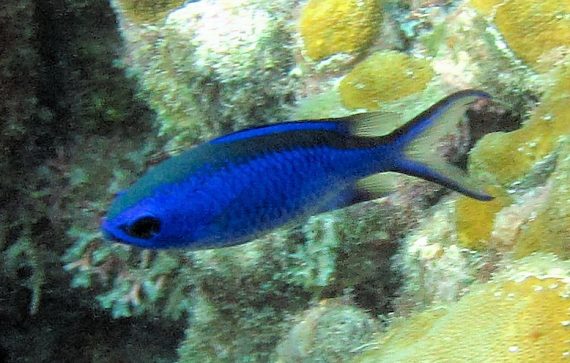Blue Chromis, Chromis cyanea

 Blue Chromis, Chromis cyanea. Underwater photographs taken in coastal waters of Bonaire, December 2019. Photographs and identifications courtesy of Bob Hillis, Ivins, Utah.
Blue Chromis, Chromis cyanea. Underwater photographs taken in coastal waters of Bonaire, December 2019. Photographs and identifications courtesy of Bob Hillis, Ivins, Utah.
The Blue Chromis, Chromis cyanea, is a member of the Damselfish or Pomacentridae Family, and is known in Mexico as castañetas azul. Globally, there are eighty-four species in the genus Chromis, of which eight are found in Mexican waters, five in the Atlantic and three in the Pacific Ocean.
The Blue Chromis has an elongated oval fusiform compressed body that is similar in nature to freshwater bluegills. They are bright blue with a black stripe along the top of the back, transitioning to a lighter blue below. The front of the anal fin, both lobes of the caudal fin and the spiny portion of the dorsal fin have a black margin. The head has a small protrusible mouth that opens in the front with 2 rows of teeth. Their anal fin has 2 spines and 13 rays; their caudal fin is deeply forked; their dorsal fin has 12 spines and 12 rays, and, the pectoral fin has 16 to 18 rays. The body is covered with large rough scales. The lateral line is incomplete and ends under the edge of the dorsal fin base.
The Blue Chromis is a solitary fish but can be found on occasion in small groups. They are a non-migratory species normally found in a shallow water reef environment at depths up to 25 m (82 feet). Juveniles remain in close proximity to the bottom to avoid predation. They reach a maximum of 15.0 cm (5.9 inches) in length. They are found on the surface of the reefs but will move into the water column to feed on plankton. They feed on aggregations of small zooplankton, primarily copepods and can be mixed in with Brown Chromis and Creole Wrasse. They will take shelter when frightened. Reproduction is oviparous with distinct pairing of individuals. The males maintain a solitary breeding territory and will mate with several females. The eggs are distributed demersally and adhere to the substrate and are guarded by the males. The eggs hatch into planktonic larvae in three days. The Blue Chromis is poorly studied with very limited information available about their lifestyle and behavioral patterns including specific details on age, growth, longevity, movement patterns, diet, habitat use, and reproduction.
The Blue Chromis is a resident of all Mexican waters of the Atlantic Ocean including the Gulf of Mexico and the east coast of the Yucatán Peninsula in the Caribbean.
The Blue Chromis is very easy to identify due to its markings, with the most similar appearing fish being the Purple Reeffish, Chromis scotti (deeper body, lacks black striping and black fin margins.
From a conservation perspective the Blue Chromis is currently considered to be of Least Concern with stable, widely distributed populations. They are utilized by the aquarium trade at a modest level being peaceful and school, however, the become territorial over time. Collectively members of the Pomacentridae Family make up almost half of the global aquarium trade. Their long-term viability is strongly dependent upon the potential loss of habitat. Degradation of coral reef habitats in the Caribbean has led to a significant decline in the density of coral reef fish for more than a decade. The recent invasion of the Caribbean by the Red Lionfish, Pterois volitans, with its aggressiveness and population explosion has reduced the abundance of coral reef fishes. Efforts to raise the Blue Chromis via farming have not been overly successful to date.